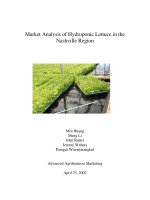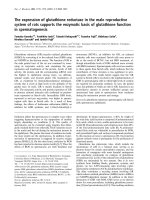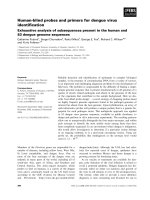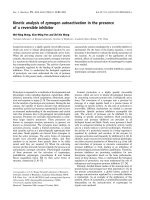Analysis of Phosphorus Behavior in the Giant Reed for Phytoremediation and the Biomass Production System
Bạn đang xem bản rút gọn của tài liệu. Xem và tải ngay bản đầy đủ của tài liệu tại đây (2.69 MB, 12 trang )
Journal of Water and Environment Technology, Vol. 7, No. 2, 2009
Analysis of Phosphorus Behavior in the Giant Reed
for Phytoremediation and the Biomass Production
System
Masaki SAGEHASHI*, Akira KAWAZOE**, Takao FUJII***, Hong-Ying HU****,
Akiyoshi SAKODA***
*Graduate School of Engineering, Tokyo University of Agriculture and Technology, Tokyo,
184-8588, Japan
**(Former Affiliation) Institute of Industrial Science, The University of Tokyo, Tokyo,
153-8505, Japan
***Institute of Industrial Science, The University of Tokyo, Tokyo, 153-8505, Japan
****ESPC State Key Joint Lab., Department of Environmental Science and Engineering,
Tsinghua University, Beijing 100084, PR China
ABSTRACT
Macrophyte-cultivated wetlands have a strong potential not only to purify eutrophic water but
also to produce biomass resources. Among a variety of macrophytes, we focused on the giant
reed (Arundo donax), and its properties of phosphorus uptake, accumulation, and translocation
were clarified in this study. Phosphorus uptake experiments using outdoor hydroponic culturing
showed the seasonal variation of phosphorus uptake by the giant reed. Furthermore, two kinetic
parameters describing the phosphorus uptake by the giant reed were obtained. Phosphorus
accumulation experiments using radioactive phosphorus suggested that giant reeds accumulate
the absorbed phosphorus in rhizomes, and it is then distributed to the leaves if needed. A
phosphorus translocation experiment using radioactive phosphorus indicated that the decreasing
of phosphorus in the leaves occurred in the order of location from the bottom to the top, which
is relevant to the order of dying down of the plant leaves actually observed in this study. Based
on these outcomes, a desirable management method for the giant reed cultivated in wetlands is
proposed.
Keywords: giant reed, phosphorus, wetland
INTRODUCTION
Water treatment using macrophyte-cultivated wetlands has attracted wide attention,
because such treatment not only purifies the environmental water but also produces
biomass resources, which can potentially be used as a substitute for fossil fuel. To date,
many studies on wetlands for water treatments have been performed (e.g., Rousseau et
al., 2008), and various plants such as the common reed (e.g., Wang et al., 2009), cattail
(e.g., Gebremariam and Beutel, 2008; Yalcuk and Ugurlu, 2009), bulrush (e.g.,
Gebremariam and Beutel, 2008), rice (e.g., Zhou et al., 2009), and free-floating
macrophytes (e.g., Nahlik and Mitsch, 2006) have been studied.
Among the variety of macrophytes cultivated in water treatment wetlands, we focused
Received February 16th, 2009, Accepted May 27th, 2009
- 143 -
Journal of Water and Environment Technology, Vol. 7, No. 2, 2009
on the giant reed (Arundo donax), which is a perennial, very tall, gramineous plant with
the rhizome as shown in Fig. 1 (Kawazoe et al., 2007). And gramine
(N-(1H-indol-3-ylmethyl)-N,N-dimethylamine), which is widely used as an initial
compound in the synthesis of a variety of substituted indoles, can be isolated from the
giant reed (Semenov and Granik, 2004). Considering these characteristics as well as its
phosphorus uptake potential and translocation activity of nutrients, we propose the
carbon and phosphorus cycles system using the giant reed as shown in Fig. 2, which can
serve as a part of the sustainable material cycles system (Kawazoe et al., 2007). In this
research, we clarify the phosphorus uptake, accumulation, and translocation properties
of the giant reed. And based on the property, we propose a management method of a
water treatment system using the giant reed.
Fig. - 1
Appearances of the Giant Reed, Reed, and Silver Grass
- 144 -
Journal of Water and Environment Technology, Vol. 7, No. 2, 2009
Fig. - 2
Carbon and Phosphorus Cycles System Using the Giant Reed
MATERIALS AND METHODS
Giant Reed
Two different-aged giant reeds were used in this study. One-year-old plants, which had
little rhizomes, were purchased from a farmer, and several-years-old plants, which had
thick rhizomes, were obtained from the botanical garden of the University of Tokyo.
Phosphorus Uptake by the Giant Reed
The phosphorus uptake by the giant reed was measured by a series of outdoor
experiments employing hydroponic culturing under various conditions. Figure 3 shows
the experimental apparatus. The surface area of the culture pot was about 154 cm2, and
the planting density of the giant reed in this experiment was thus about 65 plant/m2. In
hydroponic culturing, solid cultivation mediums such as soil are not included, to avoid
the adsorption loss of phosphorus and other changes that occur in soil.
The experimental equipment was placed on the rooftop terrace of the Institute of
Industrial Science, the University of Tokyo, which is equipped with a glass roof. The
culture broth was prepared as shown in Table 1 (SHOKUBUTSU EIYOUGAKU
JIKKEN HENSYU IINKAI, 1959). The changes in the phosphorus concentration in the
culture broths were measured by the molybdenum blue method (Japan Sewage Works
Association, 1984) every day.
The effects of age and weight of giant reeds on phosphorus uptake were estimated by
using one-year-old plants and several-years-old plants. The seasonal variation of
phosphorus uptake by giant reeds was clarified by using one-year-old plants.
- 145 -
Journal of Water and Environment Technology, Vol. 7, No. 2, 2009
14 cm
1.5 m
Fig. - 3
Table - 1
1.5 m
12 cm
Apparatus for the Phosphorus Uptake Experiment
Culture Broth used in the Phosphorus Uptake Experiment
component
(NH4)2SO4
Na2HPO4 12H2O
KCl
CaCl2
MgCl2 6H2O
FeCl3
MnCl2 4H2O
concentration
10 mg/L
(depend on experiments)
10 mg/L
2 mg/L
2 mg/L
3 mg/L
0.1 mg/L
The inorganic phosphorus uptake by the plant root can be described by the following
equation (Nielsen, 1972):
Piout + R PiR Piin + R
(1)
where, Piout is the inorganic phosphorus concentration on the outside of the plant body,
R is the transporter of the inorganic phosphorus, PiR is the phosphorus – transporter
complex, and Piin is the inorganic phosphorus ion concentration inside the cell
membrane. Thus, when the phosphorus concentration in the culture medium is constant,
the plant uptake rate, I [mg-P/(day plant)], is described as follows:
I = I max
C
C + Km
(2)
- 146 -
Journal of Water and Environment Technology, Vol. 7, No. 2, 2009
where C is the phosphorus concentration in medium [mg-P/L], Imax is the maximum
phosphorus uptake rate [mg-P/(day plant)], and Km is a constant with the same
dimension as concentration [mg-P/L]. From Eq. (2), when the concentration in medium
is changed, the amount of phosphorus uptake, N [mg-P/plant], can be described as
follows:
t
t
0
0
N = ∫ Idt = ∫ I max
C
dt
C + Km
(3)
⎛
Km
K m + C0 ⎞
=
I max Δt ⎜1 +
⎜ C − C ln K + C ⎟
⎟
n
m
n ⎠
0
⎝
where t is the time [day], C0 and Cn (C0 ≠ Cn) are the concentration of phosphorus in
culture medium when t=0 and t=n, respectively, and Δt is the time elapsed [day]. From
this equation, the parameters Imax and Km were calculated for each period based on the
measured C0, C1, and the one day’s N using the non-linear least-squares method.
Phosphorus Accumulation and Translocation in the Giant Reed
Phosphorus transport in the giant reed was directly measured by using radioactive
phosphorus (32P). Experimental plants were cultured hydroponically in a room under
fluorescent lighting of 15 watts. The distance from the fluorescent lamp to the top of the
giant reeds was about 0.2 m at the start of the experiment. The temperature in the
experimental room was kept at about 28 °C. The rhizomes and the roots of giant reeds
were soaked in Na2HPO4 aqueous solution (3.0 mg-P/L) containing a trace amount of
Na2H32PO4. The amount of phosphorus accumulated was continuously measured by
using a beta ray survey meter (ALOKA TGS-146) placed on the leaf. The amount of
phosphorus in the leaves was calculated based on the count of the beta ray, capture
efficiency, device efficiency, and a specific value of the reagent. The phosphorus
accumulation was assumed to be uniform in all the leaves, and the total amount of the
accumulation was evaluated from the total leaf area. During the measurements, plants
were shielded from beta rays by using acrylic boards of 1.0-cm thickness. The
experiment was carried out with lighting for the initial 72 hr, and afterward a 10-h
light/14-h dark lighting cycle was repeated.
To confirm the effects of declines of temperature and day length on phosphorus
transport in leaves, we performed a second, similar experiment. In this experiment, the
temperature and lighting cycle were changed to mimic the external temperature and the
day-night variation of the season, respectively. However, the light intensity was not
changed.
RESULTS AND DISCUSSION
Phosphorus Uptake by Giant Reed
The effects of age and wet weight of the giant reed on phosphorus uptake are shown in
- 147 -
Journal of Water and Environment Technology, Vol. 7, No. 2, 2009
Phosphorus uptake rate by Giant reed
2
[mg-P/day/mday)]
[mg-P/(m2 -surface]
Fig. 4. The phosphorus uptake rate of several-year-old plants was lower than that of
one-year-old plants in this weight range. As mentioned before, the several-year-old
plants have larger rhizomes, and it is possible that the phosphorus accumulated in
rhizomes affects the phosphorus uptake. A little dependency of phosphorus uptake on
plant weight was also observed, especially in one-year-old plants. However, the
fluctuation range was relatively small in this weight range. That is why we estimated the
seasonal variation of phosphorus uptake based on plant number.
90
80
70
60
50
40
30
20
1 年目の株
one-year-old
10
several-years-old
複数年目の株
0
0
Fig. - 4
100
200
300
400
Wet weight of giant reed [g/plant]
Effects of Age and Wet Weight of the Giant Reed on Phosphorus Uptake
Figure 5 shows the relationships between the phosphorus uptake and the initial
phosphorus concentration in various periods. The sizes of the one-year-old plants used
in these experiments were comparable to the one-year-old plants used in the above
mentioned experiments (Fig. 4). The phosphorus uptake was larger when the initial
phosphorus concentration was higher throughout the experiments. High phosphorus
uptake rates were observed in August and October. The uptake was very sensitive to the
climate conditions, most likely to the atmospheric temperature and sunshine. The
experimental results reflected this phenomenon.
The concentration range of this series of experiments was much higher than that
commonly found in water environments. The results show that giant reeds can be grown
in areas that are very seriously polluted by phosphorus.
- 148 -
Journal of Water and Environment Technology, Vol. 7, No. 2, 2009
1500
Phosphorus uptake rate
[mg-P/(day m2)]
[mg-P/(m2day)]
Phosphorus uptake rate
[mg-P/(day m2)]
[mg-P/(m2day)]
1500
1000
1000
500
6/4 - 6/11
7/4 - 7/5
8/11 - 8/12
500
10/29 - 10/30
11/3 - 11/4
12/25 - 12/26
0
0
0
10
20
30
40
0
50
Initial phosphorus concentration
in culture medium [mg-P/L]
Fig. - 5
10
20
30
40
50
Initial phosphorus concentration
in culture medium [mg-P/L]
Dependency of Phosphorus Uptake Rate on Initial Concentration by the
Giant Reed
(Left: June to August; Right: October to December)
The estimated Imax and Km based on each experiment (i.e., Fig. 5) are shown in Fig. 6.
Using these results, we simulated the seasonal variation of phosphorus uptake by an
ideal one-dimensional giant reed cultivated waterway (Fig. 7). In this simulation, the
loading phosphorus concentration and water loading rate were assumed to be 2.5
mg-P/L and 0.6 m/day, respectively, based on data contained in the literature (Shioda et
al., 1999).
The change in phosphorus uptake rate was not ascribed to temperature change only (Fig.
7). It is likely that other factors such as phosphorus inside of the plant body, growth
stage of the plant, and the like also affect the phosphorus uptake by giant reeds.
10
0
12/28
Date
11/28
-10
10/29
0
6/1
12/28
11/28
Date
10/29
9/29
8/30
7/31
-10
7/1
0
20
10
0
500
20
9/29
10
1000
30
8/30
1500
30
7/31
20
40
7/1
2000
40
Km [mg-P/L]
30
6/1
[mg-P/(m2day)]
Imax [mg-P/day/m2]
2500
50
Temperature [ºC]
40
Temperature [ºC]
3000
Fig. - 6 Parameters Estimated from each Experiment (Left: Imax; Right: Km;
○: Air temperature at about 3:00 PM on a day after start of each observation;
■:Imax or Km)
- 149 -
0.5
0.4
0.3
0.2
0.1
12/28
11/28
10/29
9/29
8/30
7/31
7/1
0
6/1
Phosphorus uptake rate per unit area of waterway
[g-P/(m2 day)]
Journal of Water and Environment Technology, Vol. 7, No. 2, 2009
date
Date
Fig. - 7 Calculated Phosphorus Uptake Rate in a One-Dimensional Giant Reed
Cultivated Waterway based on Estimated Imax and Km (phosphorus concentration
in loading water = 2.5 mg-P/L; water loading rate = 0.6 m/day)
Phosphorus Accumulation and Translocation in the Giant Reed
Figure 8 shows the accumulation of phosphorus in leaves measured by using radioactive
phosphorus (32P). The amount of phosphorus accumulation in leaves with lighting is
much larger than that in leaves without lighting (gray zone in Fig. 8), indicated that the
phosphorus transport for leaves was affected by lighting. The phosphorus accumulation
in leaves at 10 days after the start of the experiment was 1.7 μg/( plant day), while in an
experiment performed to clarify the amount of phosphorus uptake, the result was 134
μg/(plant day). This result suggested that giant reeds accumulated the absorbed
phosphorus in the rhizomes and distributed it to the leaves if needed. The results of
another experiment showed that more than 60% of phosphorus in the giant reed body
was located in the rhizomes (Kawazoe et al., 2007).
Note that the above mentioned value of phosphorus accumulation in leaves (ca. 1-2% in
total uptake) can not apply for actual growing sites directly. That is because we used
relatively small giant reeds (see Fig. 3) compared to those found at an actual growing
site. Relatively large (about 2 to 4 m in height (Kuwabara, 2008)) giant reeds are
commonly found in the typical giant reed habitat. The size of rhizomes and the number
of stems growing from rhizomes are also different between this study and the natural
environment. This means that the ratio of the above-ground part of the reed to the
rhizome is different, and the accumulation in leaves should be affected by the ratio.
- 150 -
Journal of Water and Environment Technology, Vol. 7, No. 2, 2009
Nonetheless, the value obtained in this study is important for the estimation of the
accumulation in relatively small plants as well as for understanding the basic properties
of phosphorus accumulation.
Accumulated phosphorus in leaves
[μg-P/plant]
8
7
1.7 μg/(day・plant)
6
5
4
3
2
1 day
1
264
240
216
192
168
144
120
96
72
48
24
0
0
Time elapsed [h]
Fig. - 8
Accumulation of Phosphorus in Leaves
Figure 9 shows the phosphorus translocation property in each leaf when the
above-ground part has died down. Here, each leaf from the bottom to the top on the
plant was assigned a number. From this figure, we see that the phosphorus in each leaf
decreased with temperature. Furthermore, the decreasing of phosphorus occurred in the
order from the bottom to the top, and this order was relevant to the dying down of the
plant leaves actually observed in this study. This result indicated that our experiments
captured the translocation of phosphorus that accompanied the dying down, and
suggested that the translocation of phosphorus possibly occurred in early September in
the lower part of the giant reed.
- 151 -
Journal of Water and Environment Technology, Vol. 7, No. 2, 2009
Room Temperature at
measurement
(11:00AM)
25
20
2
15
Leaf no. 12
1.5
10
1
5
Leaf no. 6
0.5
Fig. - 9
0
Leaf no. 1
12/13
11/28
11/13
10/29
10/14
9/29
-5
9/14
0
8/30
Newly accumulated phosphorus at each leaf
[μg-P/one leaf]
2.5
30
Temperature at measurement
Temperature at measurement
(11:00AM) [ºC]
3
Date
Phosphorus Translocation Property in each Leaf when
the Emerging Part has Died Down
Management of the Giant Reed in Wetland
Our experimental results suggested that the translocation of phosphorus from the
above-ground part and the uptake of phosphorus from the roots occurred simultaneously
after a particular season for several months in the giant reed. The phosphorus
accumulated in this period seemed to be utilized in the next year.
Based on these findings, a management method adequate to obtain the biomass of the
giant reed and maintain the wetland potential is proposed as shown in Fig. 10. In this
method, the above-ground part of the giant reeds that will remain the following year are
cropped before the start of the dying down period. Then, after all of the above-ground
part has died down, the whole plants including the roots and rhizomes are cropped
except for the roots and rhizomes remaining for the next year. Thereafter, the giant reeds
grow with the rhizome extension, and the giant reed community in the wetland is
regenerated.
- 152 -
Journal of Water and Environment Technology, Vol. 7, No. 2, 2009
Above-ground part of giant reeds that will
be remained in the next year is cropped
before start of the dying down period
All of the above-ground
part dies down
Cropping with roots and
rhizomes except for the
remaining roots and rhizomes
Growth with the
rhizome extension
Fig. - 10
Proposed Cultivation and Cropping Method of the Giant Reed in
Wetland
CONCLUSIONS
The seasonal variation of phosphorus uptake by giant reeds was observed by
phosphorus uptake experiments using outdoor hydroponic culturing, and using the
results, we obtained two kinetic parameters describing the phosphorus uptake dynamics.
The results of a phosphorus accumulation experiment using radioactive phosphorus
suggested that giant reeds accumulated phosphorus in the rhizomes, and it was
distributed to the leaves when it was required. The results of a phosphorus translocation
experiment using radioactive phosphorus indicated that the decreasing of phosphorus in
the leaves was relevant to the dying down of the plant. We proposed a desirable
management method for giant reed cultivated wetland on the basis of these results.
ACKNOWLEDGEMENT
This work was partly supported by Japan Science and Technology Agency (JST) National Natural Science Foundation of China (NSFC) Joint Program (Strategic
International Cooperative Program).
- 153 -
Journal of Water and Environment Technology, Vol. 7, No. 2, 2009
REFERENCES
Gebremariam S.Y., and Beutel M.W. (2008). Nitrate removal and DO levels in batch
wetland mesocosms: Cattail (Typha spp.) versus bulrush (Scirpus spp.), Ecological
Engineering 34(1), 1-6.
Japan Sewage Works Association (1984). GESUI SHIKEN HOUHOU -1984-, Japan
Sewage Works Association, Tokyo, 649 p. (In Japanese)
Kawazoe A., Fujii T., Sagehashi M., and Sakoda A. (2007). Carbon and Phosphorus
Cycles System Using Giant Reed, Preprints of the 7th China-Japan Symposium on
Water Environment, 107-111, 2007.
Kuwabara, Y. (1993). NIHON INEKA SYOKUBUTSU ZUFU, ZENKOKU NOUSON
KYOUIKU KYOUKAI, Tokyo, 503 p. (In Japanese)
Nahlik A.M., and Mitsch W.J. (2006). Tropical treatment wetlands dominated by
free-floating macrophytes for water quality improvement in Costa Rica, Ecological
Engineering 28(3), 246-257.
Nielsen N. E. (1972). Transport kinetic concept of ion uptake from soil by plants. II.
Concept and some theoretic considerations, Plant and Soil 37(3), 561-576.
Rousseau D. P. L., Lesage E., Story A., Vanrolleghem P. A., and De Pauw N. (2008).
Constructed wetlands for water reclamation, Desalination 218(1-3), 181-189.
Semenov
B.B.,
and
Granik
V.G.
(2004).
Chemistry
of
N-(1H-indol-3-ylmethyl)-N,Ndimethylamine (Gramine): a review, Pharmaceutical
Chemistry Journal 38(6), 287–310.
Shioda T., Yamada K., Chiba N., and Sudo R. (1999). The effect of porosity of packed
media on nitrogen and phosphorus removal in reed bed treatment system, Journal of
Japan Society on Water Environment 22(6), 505-510, 1999. (In Japanese)
SHOKUBUTSU EIYOUGAKU JIKKEN HENSYU IINKAI (1959). SHOKUBUTSU
EIYOUGAKU JIKKEN, ASAKURA SHOTEN, Tokyo, 600 p. (In Japanese)
Wang Y., Zhang J., Kong H., Inamori Y., Xu K, Inamori R., and Kondo T. (2009). A
simulation model of nitrogen transformation in reed constructed wetlands,
Desalination 235(1-3), 93-101.
Yalcuk A. and Ugurlu A. (2009) Comparison of horizontal and vertical constructed
wetland systems for landfill leachate treatment, Bioresource Technology 100(9),
2521-2526.
Zhou S., Nakashimada Y., and Hosomi M. (2009). Nitrogen transformation in vertical
flow systems with and without rice (Oryza sativa) studied with a high-resolution
soil-water profile, Ecological Engineering 35(2), 213-220.
- 154 -









